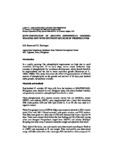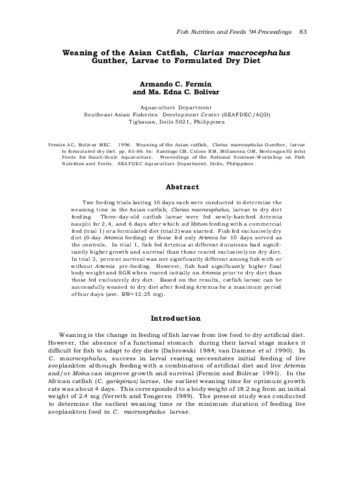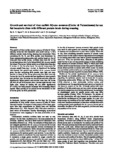Effects of weaning on survival and growth of silver therapon (Leiopotherapon plumbeus) larvae fed live and artificial diet
- Global styles
- MLA
- Vancouver
- Elsevier - Harvard
- APA
- Help
Share
Abstract
This study examined the effects of early weaning strategies on growth and survival of the silver therapon Leiopotherapon plumbeus larvae. In Trial 1, four larval age groups (8, 14, 20 and 26 days post‐hatch (dph)) were abruptly weaned to commercial powdered tilapia diet and compared with wild copepod‐fed group as the control. In Trial 2, another batch of three weaning age groups were subjected to gradual weaning (8 dph larvae with 8 days co‐feeding, 14 dph larvae with 6 days co‐feeding and 20 dph larvae with 4 days co‐feeding) with Artemia nauplii prior to weaning on commercial powdered prawn diet and compared with a control group consisted of larvae fed exclusively on Artemia nauplii. Both weaning trials were conducted for 21 days. A gradual weaning strategy promoted better survival (22.2%–40.0%) among weaning age groups than the abrupt weaning strategy (2.2%–36.7%). Except for those weaned at 26 dph, abrupt weaning resulted in significantly poor growth and survival among all weaning age groups compared with the wild copepod‐fed control group. The highest survival and growth were observed in 20 dph larvae with 4 days live food co‐feeding, although the values were significantly lower than the Artemia‐fed control group. These results suggest that abrupt weaning at 26 dph, and gradual weaning for 4 days from 20 dph promote successful rearing of silver therapon larvae and that a microparticulate diet specifically formulated for this species needs to be developed.
Suggested Citation
Aya, F., Nillasca, V. S. N., & Garcia, L. M. (2021). Effects of weaning on survival and growth of silver therapon (Leiopotherapon plumbeus) larvae fed live and artificial diet. Aquaculture Research , 52(10), 4799-4806. https://doi.org/10.1111/are.15313
Type
ArticleISSN
1355-557X; 1365-2109Collections
- Journal Articles [1258]
Related items
Showing items related by title, author, creator and subject.
-
Supplementation of grouper (Epinephelus coioides) weaning diet with different sources of phospholipids
Reyes, O. S.; Borlongan, I. G. (European Aquaculture Society, 2001)In a rapidly growing fish, phospholipid requirements are high due to rapid membrane development. At an early stage, larvae cannot synthesize large amounts of phospholipids for membrane development, which should therefore ... -
Weaning of the Asian catfish, Clarias macrocephalus Gunther, larvae to formulated dry diet
Fermin, Armando C.; Bolivar, Ma. Edna C. (Aquaculture Department, Southeast Asian Fisheries Development Center, 1996)Two feeding trials lasting 10 days each were conducted to determine the weaning time in the Asian catfish, Clarias macrocephalus, larvae to dry diet feeding. Three-day-old catfish larvae were fed newly-hatched Artemia ... -
Growth and survival of river catfish Mystus nemurus (Cuvier & Valenciennes) larvae fed isocaloric diets with different protein levels during weaning
Eguia, R. V.; Kamarudin, M. S.; Santiago, Corazon B. (Blackwell Publishing, 2000)The growth of river catfish Mystus nemurus (Cuvier & Valenciennes) larvae fed four isocaloric diets (4200 kcal kg−1) with different protein levels during weaning was determined. Diets containing 45, 50, 55, ...






